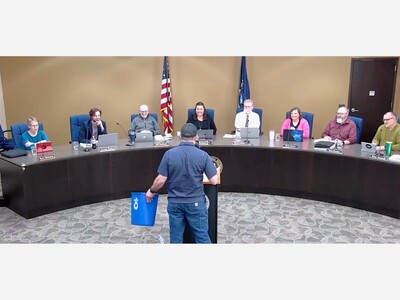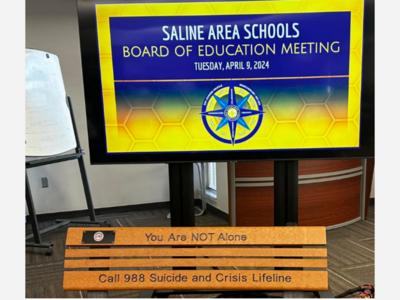Dexter: 2022 Drink Water Quality Report
2022 Drinking Water Quality Report
Dear Customer,
The City of Dexter is once again proud to present to you our Annual Drinking Water Quality Report.
Why did you get this report?
Drinking water regulations require the City to make this information available to customers each year –
it’s the law!
Why should you read it?
Let’s face it – this report isn’t going to end up on any Best Seller list. A lot of the wording is technical and mandated by law. However, the quality of our water is important, and we want to keep you informed. It can be useful in your everyday life, as well, if you have special health concerns, or just need to adjust the settings on your water softener.
What does it contain?
This report uses data collected in 2022 to summarize information about your water supply sources, the water system facilities that deliver water to your tap, and the quality of your drinking water. Also included is information about programs underway that ensure that you have safe and dependable drinking water.
Did we meet all our monitoring requirements in 2022?
In 2022, we were one month late in reporting complete metals (noted on the last page of this report) due to miscommunication with the City’s external testing lab. We have continued to meet the challenge of providing you with a safe and dependable supply of quality drinking water which meets or exceeds the requirements set forth by the United States Environmental Protection Agency (USEPA) and Michigan Department of Environment, Great Lakes, and Energy (EGLE).
What if you have questions?
Please contact Water Utilities at (734) 426-4572 if you would like help understanding the information provided, or have questions about your drinking water. This report is also available online at
https://www.dextermi.gov/Departments_Services/Water_Sewer/Water_Quality….
Get involved!
The City of Dexter Council meets at 7:00 p.m. on the 2nd and 4th Mondays of every month at 3515 Broad St., Dexter, Michigan. Look to the City of Dexter website for further information.
Water Quality Test Results
This table lists all the drinking water contaminants that we detected during the 2022 calendar year. The presence of these contaminants in the water does not necessarily indicate that the water poses a health risk. Unless otherwise noted, the data presented in this table is from testing done January 1 through December 31, 2022. The State allows us to monitor for certain contaminants less than once per year because the concentrations of these contaminants are not expected to vary significantly from year to year. All the data is representative of the water quality, but some are more than one year old.
|
Regulated Contaminant |
MCL, TT, or MRDL |
MCLG or MRDLG |
Level Detected |
Range |
Year Sampled |
Violation Yes/No |
Typical Source of Contaminant |
|
Arsenic (ppb) |
10 ppb |
0 ppb |
3 ppb |
1 – 4 ppb |
2022 |
no |
Erosion of natural deposits; Runoff from orchards; Runoff from glass and electronics production wastes |
|
Barium (ppm) |
2 ppm |
2 ppm |
0.6 ppm |
0.6 ppm |
2022 |
no |
Discharge of drilling wastes; Discharge of metal refineries; Erosion of natural deposits |
|
Chlorine (running annual average, ppm) |
4 ppm |
4 ppm |
0.5 ppm |
0.4 - 0.6 ppm |
2022 |
no |
Water additive used to control microbes |
|
Chromium (ppb) |
100ppb |
100ppb |
6 ppb |
6 ppb |
2022 |
no |
Erosion of natural deposits |
|
Fluoride (ppm) |
4 ppm |
4 ppm |
0.7 ppm |
0.2 -0.9 ppm |
2022 |
no |
Erosion of natural deposits; Water additive which promotes strong teeth; Discharge from fertilizer and aluminum factories |
|
HAA5 (sum total haloacetic acids, ppb) |
60 ppb |
N/A |
7 ppb |
0-7 ppb |
2022 |
no |
By-product of drinking water disinfection |
|
Nitrate (ppm) |
10 ppm |
10 ppm |
0.6 ppm |
0.3 - 0.9 ppm |
2022 |
no |
Runoff from fertilizer use; Leaching from septic tanks, sewage; Erosion of natural deposits |
|
Nitrite (ppm) |
1 ppm |
1 ppm |
0.04 ppm |
0 - 0.04 ppm |
2022 |
no |
Runoff from fertilizer use; Leaching from septic tanks, sewage; Erosion of natural deposits |
|
Selenium (ppb) |
50 ppb |
50 ppb |
2 ppb |
2 ppb |
2022 |
no |
Erosion of natural deposits |
|
TTHMs (sum total trihalomethanes, ppb) |
80 ppb |
N/A |
58 ppb |
6 – 21 ppb |
2022 |
no |
By-product of drinking water disinfection |
Terms used in this report:
Action Level (AL): The concentrations of a contaminant which, if exceeded, triggers treatment or other requirements that the water system must follow.
Maximum Contaminant level (MCL): The highest level of a contaminant that is allowed in drinking water. MCLs are set as close to the MCLGs (goal) as feasible using the best available treatment technology.
Maximum Residual Disinfectant Level (MRDL): The highest level of a disinfectant allowed in drinking water. There is convincing evidence that addition of a disinfectant is necessary for control of microbial contaminants.
N/A: Not applicable.
1 part per million (ppm) or milligrams per liter (mg/L) corresponds to one minute in two years or a single penny in $10,000. 1ppm – 1000 ppb.
1 part per billion (ppb) or micrograms per liter (µg/L) corresponds to one minute in 2,000 years or a single penny in $10,000,000.
|
Inorganic Contaminant Subject to Action Levels (AL) |
Action Level |
MCLG |
Your Water |
Range of Results |
Year Sampled |
Number of Samples Above AL |
Typical Source of Contaminant |
|
Lead (ppb) |
15 |
0 |
2 ppb |
0 - 10 ppb |
2022 |
0 |
Lead service lines, corrosion of household plumbing including fittings and fixtures; Erosion of natural deposits |
|
Copper (ppm) |
1.3 |
1.3 |
0.9 ppm |
0 - 0.9 ppm |
2022 |
0 |
Corrosion of household plumbing systems; Erosion of natural deposits |
Information about lead: If present, elevated levels of lead can cause serious health problems, especially for pregnant women and young children. Lead in drinking water is primarily from materials and components associated with service lines and home plumbing. The City of Dexter is responsible for providing high quality drinking water, but cannot control the variety of materials used in plumbing components. When your water has been sitting for several hours, you can minimize the potential for lead exposure by flushing your tap for 30 seconds to 2 minutes before using water for drinking or cooking. If you have a lead service line it is recommended that you run your water for at least 5 minutes to flush water from both your home plumbing and the lead service line. If you are concerned about the lead levels in your water, you may wish to have your water tested. Information on lead in drinking water, testing methods, and steps you can take to minimize exposure is available from the Safe Drinking Water Hotline
or at http://water.epa.gov/safewater/lead.Infants and children who drink water containing lead could experience delays in their physical or mental development. Children could show slight deficits in attention span and learning abilities. Adults who drink this water over many years could develop kidney problems or high blood pressure.
Copper is an essential nutrient, but some people who drink water containing copper in excess of the action level over a relatively short amount of time could experience gastrointestinal distress. Some people who drink water containing copper in excess of the action level over many years could suffer liver or kidney damage. People with Wilson’s disease should consult their personal doctor.
|
Service Line Inventory |
|
|
Copper service lines |
1061 |
|
Galvanized service line before 1988 |
30 |
|
Unknown service line material |
423 |
|
Total number of service lines |
1514 |
Our water supply has no lead service lines and 423 service lines of unknown material out of a total of 1514 service lines. Seven galvanized lines were replaced in 2022.
Monitoring and Reporting to the Department of Environment, Great Lakes, and Energy (EGLE) Requirements: The State of Michigan and the U.S. EPA require us to test our water on a regular basis to ensure its safety.
We will update this report annually and will keep you informed of any problems that may occur throughout the year as they happen. Copies are available at the city office, 3515 Broad Street, Dexter, Mi., 48130, or call 734-426-4572.
|
Other Unregulated Parameters of Interest |
Sample Average |
Results Range |
Likely Source |
|
Chloride |
122 ppm |
108-130 ppm |
Erosion of natural deposits, road runoff, industrial processes |
|
Hardness |
341 ppm |
303 - 440 ppm |
Erosion of natural deposits (multiply ppm by .058 to get grains/gallon) |
|
Sodium |
54 ppm |
42-66 ppm |
Erosion of natural deposits, road runoff, added by water softeners to remove hardness |
|
Sulfate |
36 ppm |
25-72 ppm |
Erosion of natural deposits, industrial processes |
We invite public participation in decisions that affect drinking water quality. The City of Dexter Council meets at 7:00 PM on the 2nd and 4th
Mondays of every month at 3515 Broad St., Dexter, Michigan. For more information about your water, or the contents of this report, contact Andrea Dorney at 734-426-4572. For more information about safe drinking water, visit the U.S. EPA at http://www.epa.gov/safewater
Each year, we constantly take water samples in order to determine the levels of any radioactive, biological, inorganic, volatile organic, or synthetic organic contaminants that might be present. This report includes information on all regulated drinking water contaminants detected during the calendar year of 2022. Contaminants which were tested for, but not detected, are not included in this report. Some contaminants are not required to be monitored every year because they change infrequently.
Message from the EPA
Contaminants and their presence in water: Drinking water, including bottled water, may reasonably be expected to contain at least small amounts of some contaminants. The presence of contaminants does not necessarily indicate that water poses a health risk. More information about contaminants and potential health effects can be obtained by calling the U.S. EPA’s Safe Drinking Water Hotline (800-426-4791).
Vulnerability of sub-populations: Some people may be more vulnerable to contaminants in drinking water than the general population. Immuno-compromised persons such as persons with cancer undergoing chemotherapy, persons who have undergone organ transplants, people with HIV/AIDS or other immune systems disorders, some elderly, and infants can be particularly at risk from infections. These people should seek advice about drinking water from their health care providers. USEPA/Center for Disease Control guidelines on appropriate means to lessen the risk of infection by Cryptosporidium and other microbial contaminants are available from the Safe Drinking Water Hotline
(800-426-4791).
Sources of drinking water: The sources of drinking water (both tap water and bottled water) include rivers, lakes, streams, ponds, reservoirs, springs, and wells. Our water comes from wells. As water travels over the surface of the land or through the ground, it dissolves naturally-occurring minerals and, in some cases, radioactive material, and can pick up substances resulting from the presence of animals or from human activity.
Contaminants that may be present in source water include:
- Microbial contaminants, such as viruses and bacteria, which may come from sewage treatment plants, septic systems, agricultural livestock operations, and wildlife.
- Inorganic contaminants, such as salts and metals, which can be naturally-occurring or result from urban stormwater runoff, industrial or domestic wastewater discharges, oil and gas production, mining or farming.
- Pesticides and herbicides, which may come from a variety of sources such as agriculture and residential uses.
- Radioactive contaminants, which can be naturally occurring or be the result of oil and gas production and mining activities.
- Organic chemical contaminants, including synthetic and volatile organic chemicals, which are by-products of industrial processes and petroleum production, and can also come from gas stations, urban stormwater runoff, and septic systems.
In order to ensure that tap water is safe to drink, the US EPA prescribes regulations that limit the levels of certain contaminants in water provided by public water systems. Federal Food and Drug Administration regulations establish limits for contaminants in bottled water which provide the same protection for public health.
You can receive news by email!
Are you interested in an easy way to stay current on City events and information? The City Email Update includes details of events, project updates, due date reminders, and general news. Just go to the City of Dexter homepage at www.dextermi.gov. Click on the “I Want to’ button at the top and select ‘Sign Up for E-Mail Update’ from the drop-down menu.
Mandatory Outdoor Water Restrictions
Outdoor water usage (watering lawns, washing cars, irrigation, etc.) is restricted to odd or even days based on your street address. Residents and businesses with odd-numbered addresses (addresses ending in 1, 3, 5, 7, or 9) are only allowed to water on odd-numbered days. Residents and businesses with even-numbered addresses (ending in 2, 4, 6, 8, or 0) may only water on even-numbered days. Outdoor watering is also prohibited between 6 am and 10 am. Please adjust the start time(s) for your sprinkler or irrigation system accordingly. We would like to thank you for your cooperation protecting and conserving our water resources.
From Source to Tap
Where does my water come from?
Dexter’s water comes from two well fields: one in Dexter Community Park, behind LaFontaine Chevrolet; the other behind Dexter High School, off Parker Road. There are four wells in Dexter Community Park, ranging from 200 to 225 feet deep. These feed the filtration plant on Central Street. The water is filtered, fluoridated, corrosion control added, and disinfected. Then it is pumped into the City water tower for use by the public. The single well by Dexter High School is 70 feet deep, and the pumped water is treated on-site. It is fluoridated, treated with polyphosphate for iron sequestration and corrosion control, disinfected, and pumped to the water tower for public use.
Protected Sources
In 2003, the State of Michigan conducted tritium testing to determine the relative potential for contamination of our wells by surface pollutants. The Dexter aquifer was classified by the State as “not vulnerable” to casual contamination, and the Dexter Wellhead Protection Program was instituted to help protect against other threats to our water supply.
Note from Dexter Staff regarding EGLE notice
As we noted on the first page, we failed to turn in sample results for complete metals by September 30, 2022. As a result, we are required to tell you that. As well the full version of this Consumer Confidence Report contains a formal statement mandated by the State. Missing any State deadline is serious. However, since this specific analysis is normally only done every nine years, and we turned in the testing results the following month, there is no effect on the quality of the water we delivered, and there is no reason to be alarmed.














